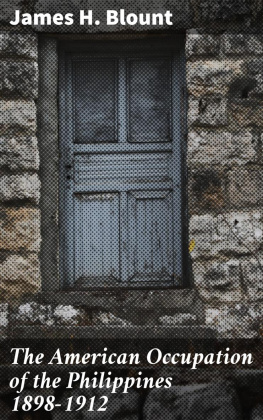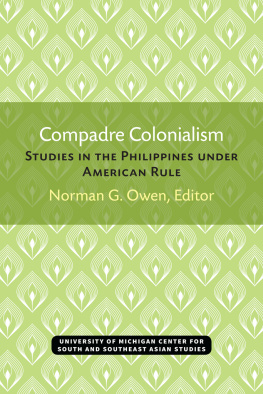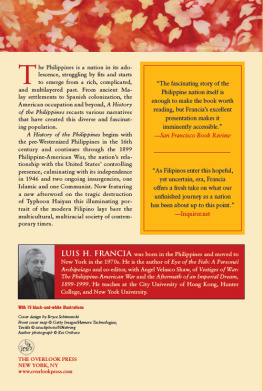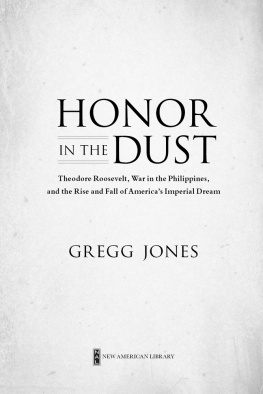The University of Chicago Press, Chicago 60637
The University of Chicago Press, Ltd., London
2017 by The University of Chicago
All rights reserved. Published 2017.
Printed in the United States of America
26 25 24 23 22 21 20 19 18 17 1 2 3 4 5
ISBN-13: 978-0-226-41776-9 (cloth)
ISBN-13: 978-0-226-41793-6 (e-book)
DOI: 10.7208/chicago/9780226417936.001.0001
Library of Congress Cataloging-in-Publication Data
Names: McKenna, Rebecca Tinio, author.
Title: American imperial pastoral : the architecture of US colonialism in the Philippines / Rebecca Tinio McKenna.
Description: Chicago ; London : The University of Chicago Press, 2017. | Includes bibliographical references and index.
Identifiers: LCCN 2016025206 | ISBN 9780226417769 (cloth : alk. paper) | ISBN 9780226417936 (e-book)
Subjects: LCSH: Baguio (Philippines)History. | PhillippinesColonization. | PhilippinesRelationsUnited States. | United StatesRelationsPhilippines. | Baguio (Philippines)Ethnic relations. | Igorot (Philippine people)PhilippinesBenguet (Province)History. | City planningPhilippinesBaguioHistory. | Burnham, Daniel Hudson, 18461912. | PhilippinesHistory18981946.
Classification: LCC DS689.B2 M35 2017 | DDC 959.9/1dc 23 LC record available at https://lccn.loc.gov/2016025206

This paper meets the requirements of ANSI/NISO Z39.481992 (Permanence of Paper).
This project began at Yale University, where I had the benefit of working with a dream-team committee of historians. Jean-Christophe Agnew has shown me a model of the intellectual life; his generosity as a teacher and scholar is an inspiration. If I enable my students half as much as he has enabled me, I will count myself a success. John Mack Faragher has been a kind mentor, and through his courses (and holiday parties), he has built intellectual communities that have endured long past Yale. The scholarship and teaching of Mary Lui and Seth Fein have shaped mine, and I am grateful for the time, encouragement, and friendship they have given me. At Yale, I had the good fortune to work with other historians whose scholarship left an imprint on me; not least of these are Dolores Hayden, John Demos, David Blight, Steven Stoll, Kevin Repp, and Cynthia Russett. My classmates were my teachers, too, and I thank especially Dara Orenstein, Kate Unterman, Lisa Pinley Covert, Julia Irwin, Barry Muchnick, Miriam Posner, and members of the Asian American Studies Workshop, all of whom read pieces of my project. I remain indebted to Dara, for hours upon hours of conversation about everything under the sun. Not least of these subjects was Baguio and US imperialism. My experience at Yale would not have been the same without her, Erin Wood, Melissa Stuckey, Brian Fobi, and Jeremi Szaniawski.
I found many more teachers when I embarked on research and presentations of my work well beyond New Haven. I thank Delfin Tolentino, Erlyn Ruth Alcantara, and Oscar Campomanes, among many others in the Philippines, who kindly welcomed me, shared their work, and offered comment on and encouragement of my own. Members of the extended Tinio family graciously opened their Baguio home to me. I am especially grateful to Martin Tinio, Jr., who taught me about Tinio family history and the political and cultural history of the Philippines. In Manila, Cesar Enrique Aguinaldo Virata, Ernie Zarate, the Alampays, the Jesenas, the Reicherts, and the Serratos were the warmest hosts and teachers. Thank you to the great many librarians and archivists from Manila to Cambridge who helped me find my way to sources. And thanks go to Scott Zillmer at Terra Carta; he produced a map of the greater Baguio region for me.
I am grateful to the moderators, co-panelists, and audience members at conferences whose comments and questions have nudged me further, especially Paul Kramer, Julie Greene, Daniel Immerwahr, Christopher Capozzola, Anne Foster, and Mae Ngai. I thank Margaret Garb and the two blind readers of my manuscript who showed tremendous generosity of time, offering me indispensable comment and critique; this project would have looked quite different without them. Im immensely grateful to Timothy Mennel at the University of Chicago Press; he has been an ideal editor and ally through the whole process. Editorial associate Rachel Kelly has answered all my questions, large and small, and kept me on track; Caterina MacLean has checked that Ive dotted my is and crossed my ts. Any errors and oversights that remain in the book are mine alone.
I could not be more fortunate in the friends, colleagues, and mentors I have found in the Department of History at the University of Notre Dame, most especially Catherine Cangany, John Deak, Paul Ocobock, Gail Bederman, Annie Coleman, Jon Coleman, Dan Graff, Karen Graubart, Patrick Griffin, Alex Martin, Richard Pierce, Jason Ruiz, Robert Sullivan, and Julia Thomas. I also thank Notre Dames Institute for Scholarship in the Liberal Arts for a grant in support of this project.
I am grateful to my extended family: Henry Hof and Rosalia and Karina Tinio Hof, Stephanie Tayengco, Francis McKenna, and all the rest of the Tinios and McKennas; Bruce and Delaney and the whole of the Lundberg clan; and my loyal Barnard College pals. Im humbled by their years of unstinting support and encouragement. I thank my immediate family for the same. Jake Lundberg is a devoted teacher and brilliant writer whose zest for history and intellectual curiosity have been renewing mine since our days sitting across each other at Sterling Library. With him near, cheering me on, distant hopeslike finishing this bookhave felt within reach. Jake inspires me to seek a full life, one that we now share with Delaney Tinio Lundberg. Countless times, while I sat at my computer, biting my lip, she took my hand, leading me to play. More often than not, this was just what I needed. She is our most wonderful gift. I thank my mother Ada Tinio McKenna. Were it not for her labor and love in caring for Delaney every day, Id still be writing. In some ways, this project is an effort to understand my mom and my dad, Thomas McKenna, and the historical currents and ironies that made possible their meeting decades ago. Their examples of love, wisdom, and faith that most things are possible continue to see me through.









 This paper meets the requirements of ANSI/NISO Z39.481992 (Permanence of Paper).
This paper meets the requirements of ANSI/NISO Z39.481992 (Permanence of Paper).